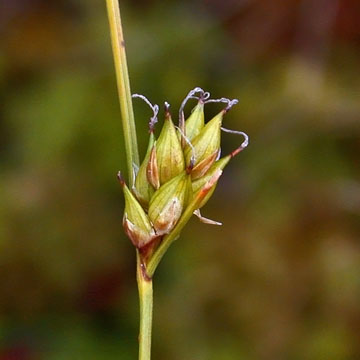

Carex oligosperma - (image 1 of 2)
Taxonomy
Family: Cyperaceae
Section Vesicariae
Habitat
Bogs, fens, shores, open swamps, in acidic, sandy or peaty soils.
Associates
Distribution
Newfoundland to Yukon, south to CT, PA, IN, WI, and MN; disjunct in NC.
Morphology
Colonial by long creeping rhizomes, often forming extensive stands; stems slender, 40-100 cm, purplish at the base; leaves pale green, stiff, elongate, involute, 1-3 mm wide; ligule much wider than long; terminal spike staminate, usually solitary or the one below it staminate as well; lower 1-2 spikes pistillate, erect, widely separated, sessile or nearly so, ovoid to short-cylindric, 1-2 cm; lowest bracts leaf-like but not sheathing; perigynia 3-15(-18), ovoid and somewhat inflated but also compressed, 4-7 mm, half as thick, strongly 7-15-nerved, abruptly narrowed to an emarginate beak 1-2 mm; achene trigonous, obovoid, 2-3 mm; style persistent, usually contorted at the base.
Notes
Fruiting June to August
Wetland indicator: OBL
Carex oligosperma is rather rare in NY but can be locally abundant in some of the larger peatlands of the Adirondacks.
References
Ball, P.W. and A.A. Reznicek. 2002. Carex, In: Flora of North America Editorial Committee, Eds. Flora of North America North of Mexico. Volume 23. Oxford University Press, New York.
Gleason, Henry A. and A. Cronquist. 1991. Manual of Vascular Plants of
Northeastern United States and Adjacent Canada. Second Ed.
The New York Botanical Garden. Bronx, NY
|
© Michael Hough 2018 |